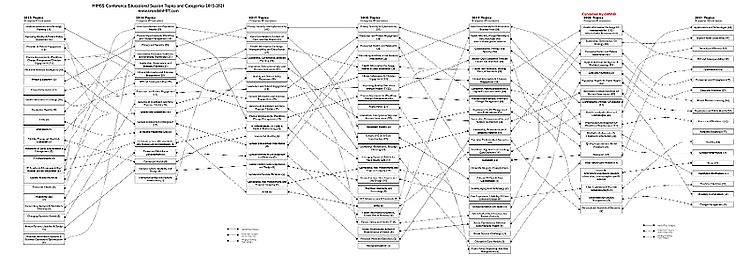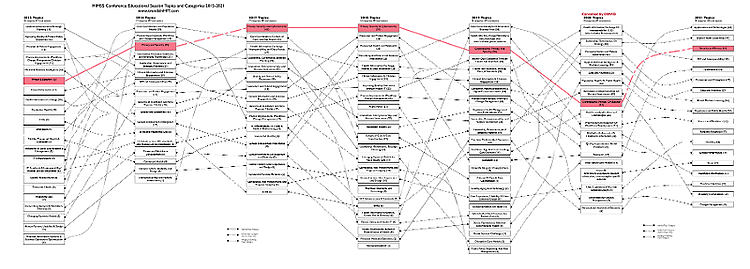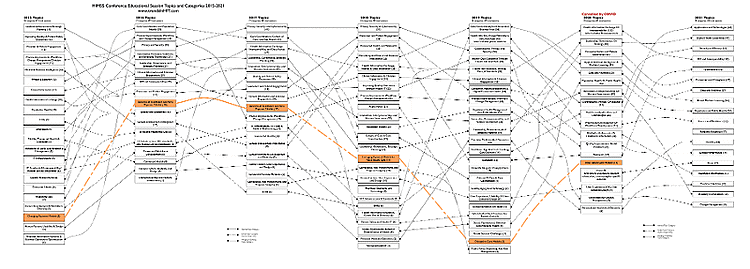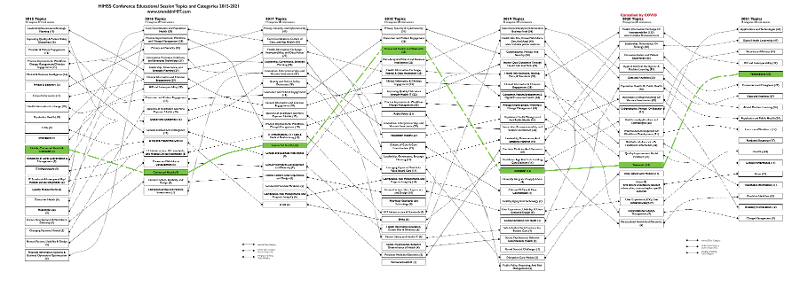Each year I look at the scheduled educational sessions at the HIMSS Conference and Exhibition to see what topics are trending and how they’re shifting over time. Last year’s conference, of course, was canceled because of COVID, but the educational sessions had already been scheduled and published, so the hiatus did not result in a data gap. This year, HIMSS is back—albeit with lower-than-average predicted attendance—and the educational track has rebounded with full force.

This year, we have 434 educational sessions in 18 categories, which is mostly on par with the 2019 figures (427 sessions in 24 categories). Scheduled events in 2020 included 681 sessions, but certain other types of meetings, such as IHE Showcase tours, were included in that total, making it artificially high.

This year the category with the most educational sessions is Applications and Technologies, with 63 sessions. That’s up from 38 sessions and 9th place last year. The category Digital Health Leadership underwent a title change but remained in 2nd place.

Security and Privacy (see the Cybersecurity trend line in red) moved from 8th place to 3rd, but the number of sessions remained constant at 41, indicating that it held steady while some of the categories ahead of it last year dropped in popularity, and there are some surprises among the categories that fell from 2020 to 2021.
Consumerization and Patient Experience, AI and Machine Learning, and Data and Analytics seem like hot topics right now, but the number of sessions in each of these categories has fallen by about half. (I also find it interesting to note that the Security and Privacy used to be called Privacy and Security, but this year the order has flipped, as if to recognize that data first has to be secure if it has any chance of being private.)
Population and Public Health also took a dive from 6th place to 9th, which is surprising in a year when public health is a topic on everyone’s mind. It’s worth mentioning, though, that a new category, Pandemic Response, has appeared, and if these two categories had been combined, they’d be tied with Security and Privacy for 3rd place.
Value-Based Care Models went from being fairly unpopular last year to completely gone this year, which is shocking when articles with titles like The shift to value-based care has accelerated in the wake of the pandemic are found everywhere in the press these days. The rise and fall and many category name changes of Value-based Care is tracked in orange.

A non-surprise is that Telemedicine (green trend line) moved up from 13th place to the number five spot. No doubt the pandemic triggered considerable interest in telemedicine, but at this point, it feels a little late to be talking about how to start a telemedicine program. Perhaps the sessions will focus on lessons learned and results observed from rolling out these programs.
When I embarked on this year-to-year analysis project five years ago, my assumption was that the most popular HIMSS educational sessions would be a leading indicator of future trends. This year we see some categories rising to prominence long after they’re already mainstream, like telemedicine and public health. At the same time, categories like value-based care models are dropping off the chart just as they are thought to be newly relevant. Perhaps the HIMSS educational sessions are a lagging indicator of trends?

For next year, I predict that some version of value-based care will return to the agenda. And security and privacy may split into separate categories. Lumping them together made sense when the topic was new, but as a subject matures it begins to specialize, and that creates an opportunity to split into separate categories.
